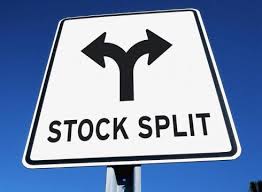What is stock split?
Stock split can be defined as issuing of new shares to the existing shareholders in proportion to current holdings. Stock split is basically dividing a stock into more number of stocks. This is generally done because of increased stock price and earnings. Stock split is generally a stock dividend of 50% or higher and less than 50% is called as simply stock dividend. Stock split is generally referred with split factor, such as split of 2:1, 7:3 etc. For example, if management declares a stock split of 3:2, it does imply that for every two shares owned by an investor, third share will be received. Stock split doesn’t create any cash flow generation and hence value of the company’s equity should stay contact. Then why do companies go for stock split if there is no change in the overall value.
Why companies go for stock split?
With the stock split, number of shares increases, say, in a 2:1 stock split number of outstanding shares will double. But this will be offset by reduction in the stock price. In theory, stock price would become exactly half of the original price in case of 2:1 stock split. What is the advantage to the companies in such case?
General belief is that stock split would increase the marketability and liquidity of a stock. Companies usually go for stock split when the stock price is too high. With the stock split, price of the stock reduces and hence it will be available to more number of marginal investors who may not buy the stock at higher price. For example, Apple announced a stock split of 7:1 in June 2014. Closing price of the stock before the stock split was $645 and it was closed at $ 93 after the stock split. Thus the Apple’s shares were made available to more number of investors.
Effect of stock split on volatility
Lower prices would attract more number of smaller investors who otherwise cannot afford that stock. Thus tradability of the stock increases with the stock splits. With the increase in trading, it is believed that demand for the stock would go up which would result in increased price of the stock there by increasing company’s value.
With such an increase in the trading, the volatility of the stock would increase. Investors might buy in large numbers in anticipation of higher returns because of the increasing demand, or it is also possible that large numbers might sell to reap the benefits of increased demand. So, the stock becomes volatile. A research conducted by Ohlson and Penman shows that stock splits cause increase in the volatility in the short term upon announcement and also increase in the volatility in the long term after the split is done.
Click here for government certification in Accounting, Banking & Finance





12 Comments. Leave new
Well defined.
Nicely executed.
Well researched
Informative!!
well explained article.
Very nicely written!
Well articulated! 🙂
Informative
Well explained.
good info
Well explained
Well explained!